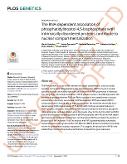The RNA-dependent association of phosphatidylinositol 4,5-bisphosphate with intrinsically disordered proteins contribute to nuclear compartmentalization

Author
Šalovská, Barbora
Antiga, Ludovica
Hoboth, Peter
Hozák, Pavel
Publication date
2024Published in
PLoS GeneticsVolume / Issue
20 (12)ISBN / ISSN
ISSN: 1553-7390ISBN / ISSN
eISSN: 1553-7404Metadata
Show full item recordCollections
This publication has a published version with DOI 10.1371/journal.pgen.1011462
Abstract
The RNA content is crucial for the formation of nuclear compartments, such as nuclear speckles and nucleoli. Phosphatidylinositol 4,5-bisphosphate (PIP2) is found in nuclear speckles, nucleoli, and nuclear lipid islets and is involved in RNA polymerase I/II transcription. Intriguingly, the nuclear localization of PIP2 was also shown to be RNA-dependent. We therefore investigated whether PIP2 and RNA cooperate in the establishment of nuclear architecture. In this study, we unveiled the RNA-dependent PIP2-associated (RDPA) nuclear proteome in human cells by mass spectrometry. We found that intrinsically disordered regions (IDRs) with polybasic PIP2-binding K/R motifs are prevalent features of RDPA proteins. Moreover, these IDRs of RDPA proteins exhibit enrichment for phosphorylation, acetylation, and ubiquitination sites. Our results show for the first time that the RDPA protein Bromodomain-containing protein 4 (BRD4) associates with PIP2 in the RNA-dependent manner via electrostatic interactions, and that altered PIP2 levels affect the number of nuclear foci of BRD4 protein. Thus, we propose that PIP2 spatiotemporally orchestrates nuclear processes through association with RNA and RDPA proteins and affects their ability to form foci presumably via phase separation. This suggests the pivotal role of PIP2 in the establishment of a functional nuclear architecture competent for gene expression.
Keywords
RNA-dependent PIP2 association, phosphatidylinositol 4,5-bisphosphate (PIP2), intrinsically disordered proteins, nuclear compartmentalization
Permanent link
https://hdl.handle.net/20.500.14178/2755License
Full text of this result is licensed under: Creative Commons Uveďte původ 4.0 International







